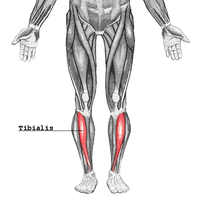
Photo from wikipedia
The interosseous crural nerve (IOCn) is said to arise distally from muscular branches of the tibial nerve innervating the deep muscles of the posterior compartment of the leg. Here, we… Click to show full abstract
The interosseous crural nerve (IOCn) is said to arise distally from muscular branches of the tibial nerve innervating the deep muscles of the posterior compartment of the leg. Here, we present the results of a cadaveric study of the IOCn to clarify this nerve's morphology and to discuss its potential clinical relevance. On twenty-six sides from thirteen cadaveric specimens, the IOCn was dissected. The IOCn was identified on fourteen out of twenty-six sides (53.8%). The mean diameter and length of the IOCn were 0.46 mm (range 0.3 to 0.72 mm) and 20.9 mm (range 13.5 to 33.0 mm), respectively. The origin of the IOCn was from a branch to the popliteus muscle on all sides. The nerve was found to have vascular, muscular, and ligamentous branches. In 53.8%, the nerve reached the inferior tibiofibular joint, and in 46.2%, the nerve terminated in the interosseous membrane of the leg (IOM). At its distal part, the IOCn gave off multiple vascular branches to the fibular artery. On one side (7.1%), the nerve pierced the interosseous membrane and innervated muscles of the anterior compartment of the leg. We believe this to be the first anatomical study of the IOCn. The nerve was found to have vascular, muscular, and ligamentous branches. Surgeons operating in the deep posterior compartment of the leg and ankle and clinicians treating patients with unusual presentations or pathology of the leg and ankle should be aware of this structure. This article is protected by copyright. All rights reserved.
Journal Title: Clinical anatomy
Year Published: 2022
Link to full text (if available)
Share on Social Media: Sign Up to like & get
recommendations!